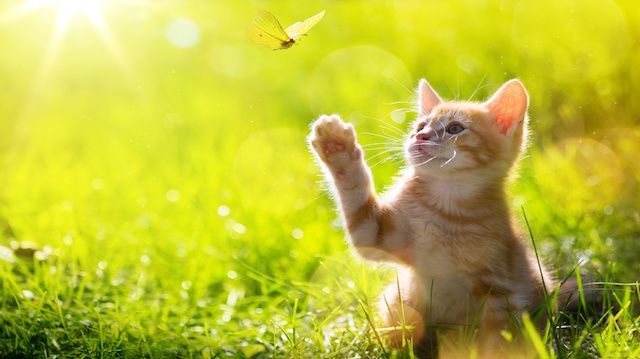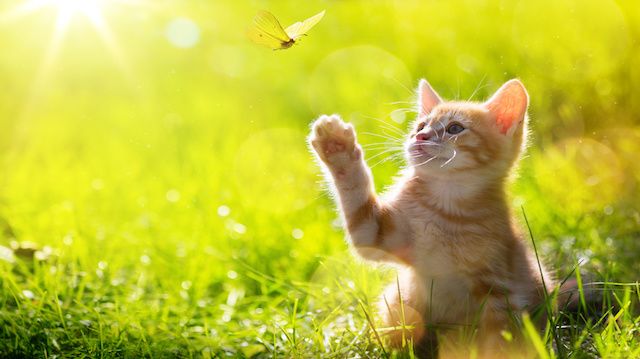
Your older cat has always had a good appetite, but now he’s constantly ravenous. Even though he’s putting away food like there’s no tomorrow, he’s getting thin.
Although your vet must make the actual diagnosis, these symptoms point to hyperthyroidism, meaning your cat is producing too much thyroid hormone. It is a common condition in aging felines. The majority of cats who are diagnosed are aged 12 or older. Fortunately, various treatment options are available.
The thyroid glands
Much like yours, your cat’s two tiny thyroid glands lie on each side of his windpipe. These glands produce thyroxine, or T4, the hormone that helps regulate the body’s metabolism. Hyperthyroidism results from either the development of tumors on one or both of the glands, or an enlargement of the glands, a condition known as hyperplasia. In either case, this causes them to produce excess hormone. Too much thyroxine throws the body out of whack, and your cat’s systems go into overdrive.
The good news is that these thyroid tumors are usually benign. Only a very small percentage of cats diagnosed with hyperthyroidism have malignant tumors.
Symptoms of hyperthyroidism
Because the thyroid glands control so much of the body’s metabolism, felines suffering from hyperthyroidism may have symptoms affecting various parts of this system. Symptoms of hyperthyroidism do run the gamut, but some are more common than others. These include:
- weight loss
- excessive thirst and subsequent increased urination
- vomiting and diarrhea
- caterwauling (constant meowing)
- increased appetite
- tachycardia (rapid heartbeat)
- panting
- poor coat quality, especially greasiness
- increased shedding
- hyperactivity
- irritability, aggression and other personality changes
Excess thyroid hormone may affect your cat’s blood pressure, heart and vision, and can result in sudden death. Some signs of hyperthyroidism are similar to those of diabetes — a deadly disease if left untreated — as well as kidney failure. If your old friend displays any of these symptoms, take him to the vet for diagnosis and treatment.
Diagnosing hyperthyroidism
Diagnosing hyperthyroidism is fairly straightforward. Based on your cat’s age and clinical signs, your vet is likely to suspect hyperthyroidism from the get-go. The vet will palpate the thyroid glands in your cat’s neck to check for enlargement and confirm the diagnosis with blood tests measuring your pet’s thyroid levels. High levels of thyroxine indicate hyperthyroidism. Your vet will conduct other tests, including X-rays and urinalysis, to ascertain the condition of your cat’s heart and kidneys.
Hyperthyroidism treatment
There are four basic treatment options for feline hyperthyroidism, and the one that’s right for your cat depends on his overall health, temperament and your budget.
Dietary management may work for some cats, but it’s not as easy as it sounds. Your cat must eat a prescription food that contains no iodine. That’s all he can eat — treats or table scraps are absolutely out. Iodine, found in a wide variety of foods, is required for the thyroid glands to produce thyroxine. By removing iodine from the diet, the thyroid glands can’t overproduce the hormone. The downside is that many cats won’t eat this food, and if you have multiple cats, they all have to eat it. It’s too risky to allow your hyperthyroid cat to consume even small morsels of “normal” feline food.
The next option is methimazole, marketed under the brand name Tapazole. This medication blocks thyroid hormone production. It’s administered once or twice daily in either pill, liquid or transdermal form for the rest of the animal’s life. For most cats, methimazole works well, but some experience serious side effects from the drug, including:
- appetite loss
- nausea and vomiting
- jaundice — yellowing of the skin, gums and whites of the eyes
- constant, repetitive body scratching
Methimazole can also cause bone-marrow suppression in some felines, so your vet must examine your cat and conduct blood and other tests on a regular basis.
If your cat is healthy enough, your vet may suggest the third option, surgical removal of the thyroid glands. However, if both glands are affected and removed, there are now no glands to produce thyroxine. That means your cat will require a daily thyroxine pill for the rest of his life.
 The final option, radioactive iodine-131 treatment, is probably the most effective way to cure hyperthyroidism, but it’s expensive and only done at certain veterinary hospitals. It’s a simple injection of radioactive iodine, which heads to the thyroid glands and eliminates abnormal thyroid cells. However, your cat is radioactive for roughly one week and will have to stay at the treatment facility. You can’t visit him during that time period.
The final option, radioactive iodine-131 treatment, is probably the most effective way to cure hyperthyroidism, but it’s expensive and only done at certain veterinary hospitals. It’s a simple injection of radioactive iodine, which heads to the thyroid glands and eliminates abnormal thyroid cells. However, your cat is radioactive for roughly one week and will have to stay at the treatment facility. You can’t visit him during that time period.
Once he is back home, you must follow a specific protocol to dispose of his litter for the next two weeks or more. Pregnant women and children should not handle the cat at all during this time period, and other people should severely limit the amount of time spent handling the cat. Anyone touching the cat must wash their hands thoroughly right afterward. Needless to say, the cat must remain indoors. Once this ordeal is over, your cat should be just fine.
With many treatment options available, there is no reason your cat can’t enjoy a long and happy life, even with a thyroid condition. As with any unusual or uncharacteristic behavior, take your pet to the vet for a thorough check.
—Jane Meggitt
Jane Meggitt graduated from New York University and worked as a staff writer for a major New Jersey newspaper chain. Her work on pets, equines and health have appeared in dozens of publications, including The Daily Puppy, The Nest Pets, Horse News, Hoof Beats and Horseback magazines.
Sources:
http://www.vet.cornell.edu/fhc/Health_Information/brochure_hyperthyroid.cfm
http://www.vetmed.wsu.edu/ClientED/hyperthyroidism.aspx
http://www.vetmed.ucdavis.edu/vmth/small_animal/internal_medicine/newsletters/hyperthyroidism_cats.cfm
http://www.animalhealthfoundation.net/blog/2012/07/feline-hyperthyroidism-symptoms-diagnosis-and-treatment/?gclid=Cj0KEQiAz5y1BRDZ4Z_K_eGa84cBEiQAtQkeaNe14pHCTtWbHAiodjtQNisPBtUGEgis-yTwoM8fpEcaAsTU8P8HAQ

